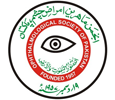ISSN 0886-3067



Volume No 36 Issue No 4
Orbital Rhabdomyosarcoma – A Case Series of 12 Patients from North – West Pakistan
Purpose: The purpose of this study is to find out demographic characteristics, clinical behavior and outcome of this neoplasm in North West Pakistan. Study Design: Retrospective Case series. Place and Duration of Study: Department of Ophthalmology, Khyber Teaching Hospital Peshawar Pakistan, from 2015 to 2019. Methods: All patients with Orbital Rhabdomyosarcoma consulting our department were registered and a self-designed proformawas used to document demography, clinical features, management, and follow-up of all cases. At the end of study, the data was analyzed using SPSS version 25 and result compiled. Results: Twelve patients with “Orbital Rhabdomyosarcoma” were included in the study with mean age of7.2 ± 1.6 years. Majority of patients presented with mass in upper lid with proptosis. On CT-Scan and/or MRI orbit proved that in seven (58.3%) cases the mass was occupying the superior orbit, in 3 (25%) cases inferior orbit and in 2 (16.6%) cases the tumor was advance enough to occupy the whole orbit.Biopsy showed embryonic type (66.7%), alveolar type (25%) and undifferentiated (8.3%). All patients received chemotherapy and radiotherapy with excision of tumor in 16.7% and exenteration in 41.7% patients. The course of follow-up extended from 7 to 24 months. Five (41.7%) patients felt well at the end of last follow-up and four (33.3%) developed recurrence. At the end of follow-up, 3 (25%) patients died of tumor. Conclusion: In North West Pakistan patients with Orbital Rhabdomyosarcoma present late and the prognosis is poor due to not following the proper protocol for follow-up.
HTML Full Text | Complete PDF